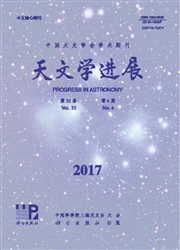

 中文摘要:
中文摘要:
该文通过综述相关研究成果,对日冕亮点的观测特征和供能机制进行了总结和评论。日冕亮点是发生在过渡区和低日冕的小尺度局地增亮现象,经常在X射线和极紫外波段观测到,其寿命在5—40h之间。日冕亮点的产生和演化与双极磁场的相互作用紧密相关。对于日冕亮点的供能机制,目前主要存在三种观点:(1)磁场对消的观点,当不同极性的磁场区域相互靠近时,局地发生磁重联,并在重联区域加热等离子体,从而导致X射线和极紫外辐射的增强;(2)分隔线重联,与日冕亮点相联系的磁场结构可以形成分隔线重联位形,沿分隔线的快速磁场重联导致过渡区和日冕局地的等离子体被加热,从而产生日冕亮点;(3)光球水平运动所诱发的电流片为亮点提供了能量来源。近期研究表明,三种机制可能同时作用,为亮点提供所需的能量。
 英文摘要:
英文摘要:
Coronal bright points (BPs) are small-scale phenomena in the solar transition region and lower corona. They can be observed as enhanced emission in X-ray, extreme-ultraviolet (EUV) and radio wave bands. Coronal bright points are found to be located at network boundaries, where bipolar magnetic fields are present. Coronal bright points are typically 10" - 40" in size, often with a bright core of 5" - 10" It is believed that a BP consists of several miniature dynamic loops which evolve at the order of seconds. The average lifetime of BPs is 20 hours in EUV and 8 hours in X-ray observations. The shorter life and smaller size of BPs seen in X-ray than in EUV suggest that BPs have a temperature of no more than 2×10^6 K. It has been found that the occurrence and evolution of BPs are strongly related with the evolution of the underlying bipolar magnetic field. Statistic study reveals that 2/3 of the BPs are associated with the cancelation of magnetic features, while the other 1/3 are associated with the emergence of magnetic fluxes. Transition region lines often show red shift or small blue shift in coronal bright points, indicating that BPs are not directly associated with transition region explosive events and do not contribute significantly to the solar wind outflow. It is also found that both up and down flows with speeds of several tens km/s are present in the transition region and corona in bright point regions. The flows might be associated with magnetic reconnection, or due to the geometry of magnetic loop systems associated with BPs. The electron densities of BPs can be derived by using line pairs which are density sensitive. It is found that bright point densities,lg Ne , are in the range of 9.0- 10.0 at coronal temperatures (lg(T/K) = 6.0- 6.3), and lgNe = 10.0- 11.0 at transition region temperatures (lg(T/K) = 5.2 - 5.4). These values are higher than those of the normal quiet Sun, and lower than or similar to those of typical active regions. From a theoretical point of view,
 同期刊论文项目
同期刊论文项目
 同项目期刊论文
同项目期刊论文
 Horizontal supergranule-scale motions inferred from TRACE ultraviolet observations of the chromosphe
Horizontal supergranule-scale motions inferred from TRACE ultraviolet observations of the chromosphe Upward propagating high-frequency Alfvén waves as identified from dynamic wave-like spicules observe
Upward propagating high-frequency Alfvén waves as identified from dynamic wave-like spicules observe Reconfiguration of the coronal magnetic field by means of reconnection driven by photospheric magnet
Reconfiguration of the coronal magnetic field by means of reconnection driven by photospheric magnet 期刊信息
期刊信息
